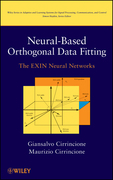
Neural based orthogonal data fitting: the EXIN neural networks
Cirrincione, Giansalvo
Cirrincione, Maurizio
Written by three leaders in the field of neural based algorithms, Neural Based Orthogonal Data Fitting proposes several neural networks, all endowed with acomplete theory which not only explains their behavior, but also compares them with the existing neural and traditional algorithms. The algorithms are studied from different points of view, including: as a differential geometry problem, as a dynamic problem, as a stochastic problem, and as a numerical problem.All algorithms have also been analyzed on real time problems (large dimensional data matrices) and have shown accurate solutions. Where most books on the subject are dedicated to PCA (principal component analysis) and consider MCA (minor component analysis) as simply a consequence, this is the fist book to start from the MCA problem and arrive at important conclusions about the PCA problem INDICE: List of Figures. List of Tables. Acknowledgments. Preface. 1.The Total Least Squares Problems. 1.1 Introduction. 1.2 Some TLS Applications. 1.3 Preliminaries. 1.4 Ordinary Least Squares Problems. 1.5 Basic TLS Problem. 1.6Multidimensional TLS Problem. 1.7 Nongeneric Unidimensional TLS Problem. 1.8 Mixed OLS-TLS Problem. 1.9 Algebraic Comparisons between TLS and OLS. 1.10 Statistical Properties and Validity. 1.11 Basic Data Least Squares Problem. 1.12 The Partial TLS Algorithm. 1.13 Iterative Computation Methods. 1.14 Rayleigh Quotient Minimization Non Neural and Neural Methods. 2. The MCA EXIN Neuron. 2.1 The Rayleigh Quotient. 2.2 The Minor Component Analysis. 2.3 The MCA EXIN Linear Neuron. 2.4 The Rayleigh Quotient Gradient Flows. 2.5 The MCA EXIN ODE Stability Analysis. 2.6 Dynamics of the MCA Neurons. 2.7 Fluctuations (Dynamic Stability) and Learning Rate. 2.8 Numerical Considerations. 2.9 TLS Hyperplane Fitting. 2.10 Simulations for the MCA EXIN Neuron. 2.11 Conclusions. 3. Variants of the MCA EXIN Neuron. 3.1 High Order MCA Neurons. 3.2 The Robust MCA EXINNonlinear Neuron (NMCA EXIN). 3.3 Extensions of the Neural MCA. 4. Introduction to the TLS EXIN Neuron. 4.1 From MCA EXIN to TLS EXIN. 4.2 Deterministic Proof ad Batch Mode. 4.3 Acceleration Techniques. 4.4 Comparison with TLS GAO. 4.5 A TLS Application: Adaptive IIR Flitering. 4.6 Numerical Considerations. 4.7 The TLS Cost Landscape (geometric approach). 4.8 First Considerations on theTLS Stability Analysis. 5. Generalization of Linear Regression Problems. 5.1 Introduction. 5.2 The Generalized Total Least Squares (GeTLS EXIN) approach. 5.3 The GeTLS Stability Analysis. 5.4 Neural Nongeneric Unidimensional TLS. 5.5Scheduling. 5.6 The Accelerated MCA EXIN Neuron (MCA EXIN+). 5.7 Further Considerations. 6. The GeMCA EXIN theory. 6.1 The GeMCA Approach. 6.2 Analysis of matrix K. 6.3 Analysis of the derivative of the eigensystem of GeTLS EXIN. 6.4Rank one analysis around the TLS solution. 6.5 The GeMCA spectra. 6.6 Qualitative analysis of the critical points of the GeMCA EXIN error function. 6.7 Conclusion. References. Index.
- ISBN: 978-0-471-32270-2
- Editorial: John Wiley & Sons
- Encuadernacion: Cartoné
- Páginas: 288
- Fecha Publicación: 26/11/2010
- Nº Volúmenes: 1
- Idioma: Inglés
